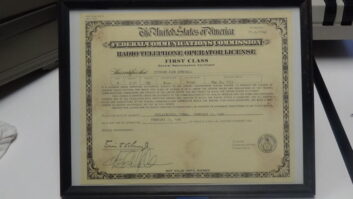
Looking beyond translator windows to other rule changes proposed by the FCC, an ownership group is contacting fellow AM licensees in the hopes of winning support for “across the board, fair treatment” of the Class C occupants of the band’s five “local channels.”
AM band frequencies are divided into three categories in the United States: clear, regional and local channels. A local channel is one on which stations operate unlimited time and serve primarily a community and its suburban and rural areas. A Class C station operates on one of those channels with power up to 1 kW. There are five Class C local channels: 1230, 1240, 1340, 1400, 1450 and 1490 kHz.
Lee Afflerbach is partner in CTC Media Group, based in Royal Oak, Md., which owns AM stations WNOS and WWNB in New Bern, N.C. In an email to fellow broadcasters, he wrote that the opportunity for AM broadcasters to have a strong, higher quality AM signal in their market is at least as important as the chance to obtain FM translators.
“In this regard, the FCC is proposing to raise the overall level of signal intensity for the AM service to enhance signal quality, reducing noise from power lines and electronic devices,” he wrote. “The signal increase will be achieved by raising the station’s licensed transmitter power, typically 4 to 16 times their current daytime power levels.” CTC supports that idea.
But in his reading of the proposal, there is a specific concern.
“Unfortunately, under the existing FCC rules, ‘Local Channel’ stations (defined as Class C stations in the FCC rules) are excluded from this proposed power increase since under the FCC’s existing regulations, Class C stations have a maximum daytime power of 1 kW,” he wrote. “That is, even under the proposed new rules, the FCC has NOT made any changes to the existing definition of the Class C station (which sets the maximum power at 1,000 watts for day and nighttime).”
He said this means that about 20% of all AM stations — all the Class C stations in the U.S. — would remain limited to a daytime power of 1 kW power even after “revitalization” takes effect.
“Even worse, the remaining 80% of AM stations potentially will have the opportunity to theoretically raise their daytime power to 50 kW,” Afflerbach wrote. “This would make the Class C ‘local channel’ AM stations even less viable (and valuable) than other AMs — or even less than they were before.”
Afflerbach encouraged “local station” owners to consider filing comments and specifically to support proposed power increases for Class C stations to a power of 4 kW, “or to redefine the Class C stations without regard to maximum transmitter power.” He encouraged owners to discuss any questions with their station engineers or FCC attorney, or to contact CTC Media Group via email.
Comments are due in MB Docket No. 13-249 by March 21.












